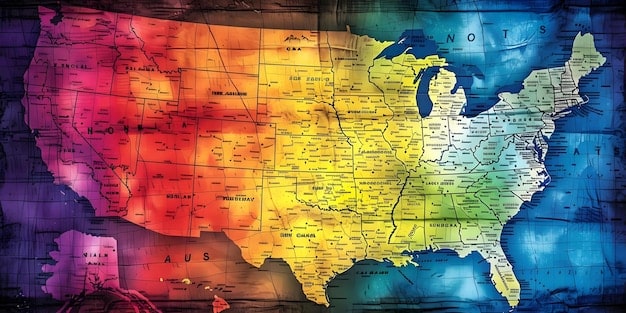US Time Zones: Ultimate Guide to Plan Your Trip & Avoid Jet Lag

Anúncios
Navigating US time zones is crucial for seamless travel within the country and minimizing jet lag; understanding these zones and implementing strategic tips can significantly enhance both your trip planning and overall well-being.
Planning a trip across the United States? Understanding the intricacies of the US time zones is the first step to a smooth journey. This The Ultimate Guide to US Time Zones: Plan Your Trip and Avoid Jet Lag with These Tips will help you navigate the complexities and arrive refreshed, ready to explore.
Anúncios
Understanding US Time Zones
The United States spans several time zones, each affecting travel plans and daily schedules. A clear understanding of these zones helps in managing appointments, travel itineraries, and communication across different states.
The Standard Time Zones
The US officially recognizes nine standard time zones, each offset from Coordinated Universal Time (UTC). These include:
Anúncios
- Eastern Time Zone (ET): UTC-5 during standard time, UTC-4 during daylight saving time.
- Central Time Zone (CT): UTC-6 during standard time, UTC-5 during daylight saving time.
- Mountain Time Zone (MT): UTC-7 during standard time, UTC-6 during daylight saving time.
- Pacific Time Zone (PT): UTC-8 during standard time, UTC-7 during daylight saving time.
Beyond these, Alaska, Hawaii, and US territories in the Pacific also have their own time zones.
Daylight Saving Time (DST)
Daylight Saving Time is observed from the second Sunday in March to the first Sunday in November. During this period, clocks are advanced by one hour, effectively shifting the time zones.
- DST aims to make better use of daylight during the warmer months.
- Not all states observe DST; Arizona (except for the Navajo Nation) and Hawaii do not participate.
- Understanding DST is crucial when scheduling events and travel across time zones.
Knowing when DST begins and ends can prevent confusion and ensure timely arrivals and departures.

In conclusion, understanding the structure of US time zones, including the specifics of DST, is vital for efficiently planning any trip across the country. This knowledge helps avoid scheduling mishaps and ensures smooth transitions between different regions.
Planning Your Trip Across Time Zones
Effective planning involves considering the practical implications of crossing multiple time zones. This requires meticulous scheduling and an awareness of the potential for disruptions to your normal routines.
Coordinating Flights and Transportation
When booking flights, always double-check the arrival and departure times, noting the corresponding time zones. This can save a lot of confusion and prevent missing connections.
- Confirm all times in your itinerary reflect the local time zone.
- Use online tools or apps that automatically convert times for different zones.
- Factor in potential delays and layovers, which can further complicate time zone transitions.
Proper flight coordination can ensure a smooth start to your trip and reduce the chances of unnecessary stress.
Scheduling Meetings and Calls
If your trip involves business interactions, be considerate of the time differences when scheduling meetings or calls. Early morning on the East Coast is still nighttime on the West Coast, and vice versa.
- Use a time zone converter to find the most suitable time for all participants.
- Consider sending a calendar invite with times adjusted for each recipient’s time zone.
- Be flexible and accommodating to ensure everyone can participate comfortably.
Thoughtful scheduling can strengthen professional relationships and ensure productive communication during your travel.
Adjusting to Local Time
Upon arrival at your destination, try to adjust to the local time as quickly as possible. This can help mitigate the effects of jet lag.
- Set your watch and other devices to the local time immediately.
- Try to align your meal and sleep times with the local schedule.
- Engage in activities that expose you to natural light during the day to help regulate your body clock.
Adapting promptly to local time can help you feel more energized and ready to explore.
In summary, thoughtful coordination of flights and meetings, along with proactive adjustment to local time, are crucial elements of planning a successful trip across US time zones. These strategies help manage the logistical challenges and minimize potential disruptions.
Combating Jet Lag: Strategies and Tips
Jet lag can significantly affect your enjoyment of a trip. It occurs when your body’s natural rhythms are disrupted by crossing multiple time zones, but strategic interventions can minimize its impact.
Understanding Jet Lag
Jet lag manifests as fatigue, insomnia, digestive issues, and difficulty concentrating. It is primarily caused by the misalignment between your internal body clock and the new time zone.
Factors that exacerbate jet lag include:
- Traveling eastward, which shortens your day.
- Stress and lack of sleep before departure.
- Dehydration during the flight.
Understanding these factors can help you anticipate and manage potential symptoms.

Pre-Travel Adjustments
Preparing your body before your trip can make the transition easier. Gradual adjustments to your sleep schedule can prime your body for the new time zone.
Strategies to consider:
- Start shifting your sleep schedule a few days before departure, adjusting by one or two hours each day.
- Ensure you are well-rested before starting your journey.
During the Flight
What you do during the flight can significantly impact how you feel upon arrival. Staying hydrated and avoiding certain substances can help alleviate symptoms.
Recommended practices include:
- Drinking plenty of water to stay hydrated.
- Avoiding alcohol and caffeine, which can disrupt sleep patterns.
- Trying to sleep during the flight if it corresponds with nighttime at your destination.
Post-Arrival Strategies
Once you arrive, focus on synchronizing your body clock with the local time. Exposure to sunlight and consistent meal times can help.
Effective methods include:
- Spending time outdoors during daylight hours to regulate your body clock.
- Eating meals at local times, even if you are not hungry.
- Avoiding naps, unless absolutely necessary, to prevent disrupting your sleep schedule.
Consistent efforts to realign your body clock can help minimize the duration and intensity of jet lag.
Leveraging Technology for Time Zone Management
Technology offers numerous tools and applications to help manage time zones, plan schedules, and mitigate the effects of jet lag. Utilizing these resources can significantly streamline your travel experience.
Time Zone Converter Apps
Time zone converter apps provide real-time conversions, assisting in scheduling calls and meetings across different zones. These apps typically offer intuitive interfaces and customizable features.
Popular options include:
- World Time Buddy: Useful for scheduling meetings with multiple participants in different time zones.
- Time Zone Converter: A straightforward tool for quick conversions.
Travel Planning Apps
Travel planning apps integrate time zone information into itineraries, ensuring all scheduled events are accurately timed. These apps can sync with your calendar and provide reminders based on your location.
Notable apps:
- TripIt: Organizes travel plans, including flight and hotel confirmations, into a seamless itinerary.
- Google Travel: Offers comprehensive travel planning tools with time zone management features.
Jet Lag Calculators
Jet lag calculators analyze your travel itinerary and provide personalized recommendations for adjusting your sleep schedule and managing symptoms. These tools consider factors like direction of travel and number of time zones crossed.
Recommended calculators:
- Jet Lag Rooster: Generates a tailored plan to minimize jet lag based on your specific travel details.
- Entrain: Uses scientific research to provide optimal light exposure schedules for adjusting your body clock.
Smartwatches and Fitness Trackers
Smartwatches and fitness trackers monitor your sleep patterns and provide insights into your body’s adjustment to new time zones. Many devices offer features to track sleep quality and recommend optimal sleep times.
Available tools:
- Apple Watch: Provides detailed sleep tracking and integrates with health apps.
- Fitbit: Offers sleep scores and personalized recommendations for improving sleep habits.
Using technology effectively can greatly simplify time zone management, ensuring a smoother and more enjoyable travel experience by helping to adapt faster and stay organized.
Real-Life Scenarios and Solutions
Practical applications of time zone knowledge can make a significant difference in various travel scenarios, from leisure trips to business engagements. Being prepared for common challenges ensures smoother experiences.
Scenario 1: Business Trip from New York to Los Angeles
Traveling from New York (ET) to Los Angeles (PT) involves a three-hour time difference. This requires careful planning to ensure productivity and minimize disruption.
Solutions:
- Schedule important meetings for the afternoon in Los Angeles, allowing time to adjust upon arrival.
- Communicate availability to East Coast colleagues, indicating the adjusted working hours.
Scenario 2: Family Vacation from Chicago to Orlando
A family vacation from Chicago (CT) to Orlando (ET) involves crossing into a new time zone, requiring adjustments for children’s routines.
Solutions:
- Gradually shift bedtime and meal times a few days before departure.
- Upon arrival, immediately set devices to local time to reinforce the new schedule.
Scenario 3: Connecting Flights Through Denver
Navigating connecting flights through Denver (MT) requires attention to arrival and departure times to avoid missing connections.
Solutions:
- Confirm all flight times reflect the local time zone of each airport.
- Use travel apps to track flight schedules and receive real-time updates.
Scenario 4: Remote Work Across Time Zones
Managing remote work across different time zones requires effective communication and scheduling strategies.
Solutions:
- Establish clear communication protocols, including availability and response times.
- Use collaborative tools like Slack or Microsoft Teams to coordinate tasks and meetings.
Being prepared and understanding how to address these scenarios can greatly improve your travel experience.
Advanced Tips for Frequent Travelers
Frequent travelers can benefit from incorporating advanced strategies into their routines to minimize the long-term effects of frequent time zone transitions. These practices focus on promoting overall health and well-being.
Maintaining a Consistent Sleep Schedule
Even when traveling, maintaining a consistent sleep schedule can help regulate the body clock. Aim to sleep and wake at the same times each day, regardless of the time zone.
Practices to consider:
- Use blackout curtains or a sleep mask to create a dark sleep environment.
- Avoid screen time before bed to reduce exposure to blue light.
Optimizing Diet and Hydration
Proper nutrition and hydration are key to mitigating jet lag and promoting overall wellness. Consider incorporating foods and beverages that support sleep and energy levels.
Strategies to implement:
- Eat light meals that are easy to digest when traveling.
- Avoid processed foods and sugary drinks that can disrupt sleep.
Incorporating Exercise and Movement
Regular physical activity promotes better sleep and reduces stress, helping the body adapt to new time zones. Engage in light exercise and movement during and after travel.
Beneficial practices:
- Stretch or walk around the airport during layovers.
- Engage in outdoor activities upon arrival to promote natural light exposure.
Seeking Professional Guidance
Consulting with a healthcare provider or sleep specialist can provide personalized strategies for managing jet lag and optimizing sleep health. This can be particularly beneficial for those with underlying health conditions.
Consider seeking guidance on:
- Melatonin supplements to regulate sleep patterns.
- Cognitive behavioral therapy for insomnia (CBT-I) to improve sleep quality.
| Key Point | Brief Description |
|---|---|
| ✈️ Plan Flights Carefully | Confirm arrival/departure times, noting time zones. |
| ⏰ Adjust to Local Time | Set devices to local time immediately upon arrival. |
| 💧 Stay Hydrated | Drink plenty of water during and after your flight. |
| ☀️ Get Sunlight | Expose yourself to natural light to regulate your body clock. |
Frequently Asked Questions (FAQ)
▼
There are four primary time zones in the continental US: Eastern, Central, Mountain, and Pacific. These zones help coordinate schedules and travel across different regions of the country.
▼
Daylight Saving Time (DST) is the practice of advancing clocks one hour during the warmer months. In the US, it begins on the second Sunday in March and ends on the first Sunday in November.
▼
To adjust to a new time zone, set your devices to local time upon arrival, expose yourself to sunlight during the day, and try to align your meal and sleep times with the local schedule.
▼
To prevent jet lag, stay hydrated during your flight, avoid alcohol and caffeine, try to sleep on the plane if it corresponds with nighttime at your destination, and adjust your sleep schedule before traveling.
▼
Yes, there are several apps available, such as World Time Buddy and Time Zone Converter, that can help manage time zone differences by providing real-time conversions and scheduling assistance.
Conclusion
Navigating US time zones and minimizing jet lag requires careful planning and proactive strategies. By understanding the structure of time zones, coordinating travel schedules, and implementing effective jet lag remedies, you can ensure a smoother and more enjoyable travel experience, whether for business or leisure.





